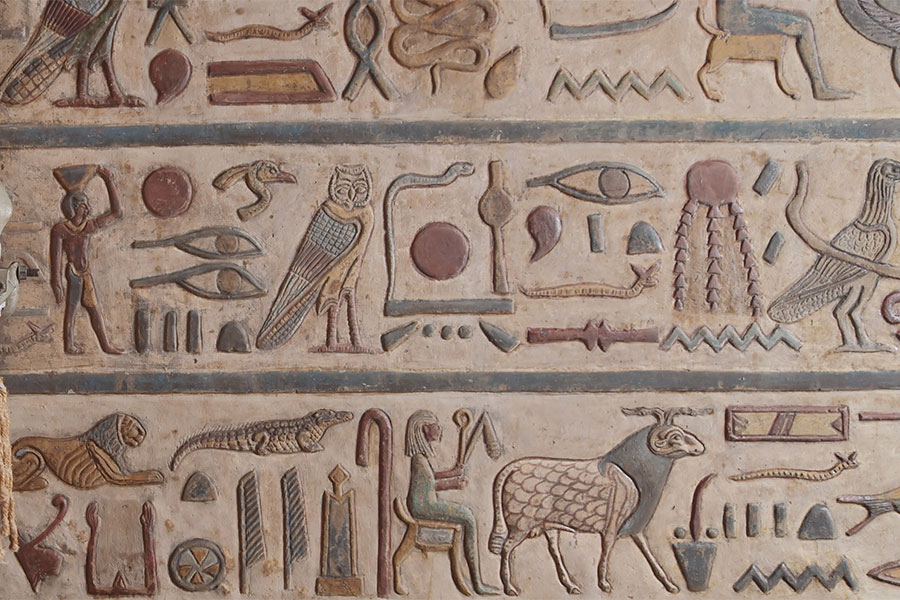A joint German-Egyptian archaeological mission, who’ve been working at Egypt’s Esna temple since 2020, have succeeded in uncovering patterns, pictures, and colors from the ceilings and walls of the temple. With restoration and cleaning work completed, bright patterns and colors have been found depicting eagles and cobra heads, amongst others, as per a statement released by the Egyptian Ministry of Tourism and Antiquities .

The temple of Esna, also known as the Temple of Khnum, is dedicated to the ram-headed god, Khnum (god of creation), and his divine consorts Menhit and Nebtu, their son, Heka, and the goddess Neith.
It’s located 100 meters (328 feet) west of the bank of the river Nile in Esna City. Most of the temple was constructed during the reign of Emperor Claudius (41-54 AD) and was completed during the reign of Emperor Decius (249-251 AD), reports Ahram Online . The temple ruins consist of a hall of columns with ornate pillars caved with lotus and palm designs. The walls are covered with reliefs showing Ptolemaic and Roman Emperors offering sacrifices to the god Khnum.

The Esna temple restoration project removed 2,000 years of dust and grime to reveal this exceptionally clear and bright images.
Esna Temple Restoration: Details and Cobra Goddess Wadjet!
“This is the first time to find this relief,” said Dr. Mostafa Waziri, Secretary General of the Supreme Council of Antiquities, referring to a unique depiction of the cobra goddess Wadjet. The spectacular Wadjet relief was not mentioned in the works published by the French Egyptologist Serge Soniron, who documented the temple’s reliefs between 1963 and 1975, said Waziri.
Dr. Waziri added that these patterns and colors were found under the middle ceiling above the entrance of the temple of Esna at a height of 14 meters (45.9 feet). Here, the painting depicts symmetric beauty: 46 eagles in two rows, with 22 of these eagles having cobra heads that represent Wadjet, the goddess, matron, and protector of Lower Egypt . The remainder are cobra heads representing Upper Egypt.

Interestingly, this representation of Wadjet has not appeared in any other painting or images before. Wadjet is generally portrayed with the sun disk called an uraeus. In Egyptian mythology, Wadjet is the protector of Lower Egypt, until the unification of the Upper and Lower regions. In a lot of historical records, after this unification, her association was tied to Nekhbet, who is depicted as a white vulture , and joins Wadjet on the crown with the cobra uraeus.
The Esna Temple regulated sexuality and purity through the compliance with strict rules regarding both. From other inscriptions found on the temple walls, all those entering the temple fastidiously had to cut their fingernails, toenails, remove body hair, purify their hands, forbidden from wearing wool (only linen to be permitted), and to have not had intercourse for many days.

Dr. Hisham El-Lithy, head of the Central Administration for Egyptian Archaeology Registration and Head of the Egyptian Archaeological Mission said: “The colorful inscriptions have suffered over the past centuries from the accumulation of thick layers and impurities.” This included soot, dust, dirt, bird and bat droppings, spider’ cobwebs, salt calcifications, which has accumulated over the last 2,000 years.
Owing to these factors, the Esna Temple restoration project was seen as vital for the preservation of the unique and distinctive inscriptions from the pre-Roman and Roman era. Funding was primarily received from the American Research Center in Cairo, and from other sources.

The Esna temple restoration work was meticulously and literally brought ancient work back to life.
The Timeline of the Temple of Esna
The director of the restoration team, Ahmed Imam stated that cleaning the western wall in the axis of the temple also revealed a Greek inscription drawing in red ink. It was covered completely under a black rug. Preliminary studies of this text date it to Emperor Domitian (81-96 AD). The inscription records the day and month (Epiphi 5), this corresponds to the reign of Domitian at the end of June or beginning July.
The inscription records the day and eleventh month of the ancient Egyptian and Coptic calendars, “EPIPHI 5,” reports Heritage Daily . It is likely that the construction of the temple was completed during this time. The 19th and 20th centuries saw the temple of Esna suffer from urban encroachment.
This probably resulted in limiting access of the site only through one of the houses built around it. During the reign of Albanian Ottoman governor, Mohamed Ali Pasha (1805-1840 AD), the temple is reported to have been used as a storage facility and warehouse for the cotton crop. Moving forward, further archaeological excavations in and around the site are slated to be conducted to uncover more details.





